Automotive head unit
An automotive head unit, sometimes called the infotainment system,[1] is a component providing a unified hardware interface for the system, including screens, buttons and system controls for numerous integrated information and entertainment functions.
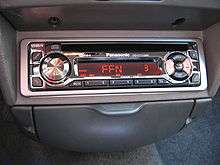
_Head_Unit.jpg)
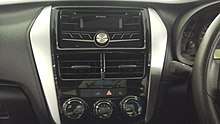
Other names for automotive head units include car stereo, car receiver, deck, in-dash stereo, and dash stereo.
Function
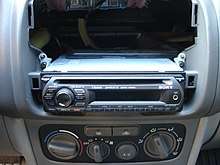
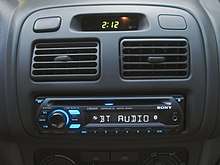
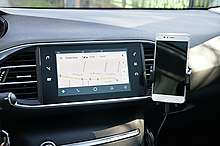
Central to a vehicle's sound and information systems, head units are located prominently in the center of the dashboard or console, and provide an integrated electronic package.
The head unit provides a user interface for the vehicle's information and entertainment media components: AM/FM radio, satellite radio, DVDs/CDs, cassette tapes (although these are now uncommon), USB MP3, Dashcams, GPS navi, Bluetooth, WiFi, and sometimes vehicles systems status — and may provide control of audio functions including volume, band, frequency, speaker balance, speaker fade, bass, treble, EQ and so on.[2] With the advent of dashcams, GPS navigation and DVDs, head units with video screens are widely available, integrating voice control and gesture recognition.
Size standards
An original standard head unit size is ISO 7736, developed by the Deutsches Institut für Normung (DIN):
Single DIN (180 mm × 50 mm or 7.09 in × 1.97 in) in Europe, South America and Australasia
- A compact size that easily fits into a dashboard, but the unit is not tall enough to accommodate a video display.
Double DIN (180 mm × 100 mm or 7.09 in × 3.94 in) in Japan, the UK and North America. Double DIN is also written as 2 DIN and double din.
- Doubling the height of the single DIN, a video display or touchscreen can be fitted to support manufacturer GUIs, Android Auto and/or Apple CarPlay.[3]
ISO 10487 is the standard for connectors for the head unit to the car's electrical system.
See also
- Aftermarket
- Android Auto
- CarPlay
- Connectors for car audio
- Vehicle audio
References
- "7 Ways Your Car is Turning Into a Mobile Device". Motor Trend. Retrieved 2020-02-27.
- "How important is your car stereo to you". Head unit. dbm automotive. Aug 2019. Retrieved 2012-01-03.
- "Single Din vs Double Din- Din Size Chart 2019 by Stereo Authority". Stereo Authority. 2018-11-02. Retrieved 2018-12-02.
- OEM Steering Wheel Control for aftermarket radios
- pac-audio.com Archived 2014-03-06 at the Wayback Machine
External links
- MPT 1362 UK code of practice for the installation of mobile radio and ancillary equipment in land based vehicles. Federation of Communications Services Industry, November 2005.
- 2 Din In-Dash Headunit